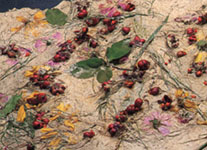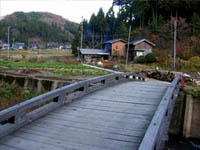 |

|
 |
 |
|
|
Noto
Handmade Washi Paper
"A bride that fell in love with making handmade washi"
Tomi Kyomi wished to learn how to make handmade washi paper and moved
from her home town in Kanazawa, to Nigyo, a village located in the
southern part of Noto Peninsula. She was in her teens when she came
the Tomi family as a bride. Nigyo is not at all famous for handmade
paper; in fact, her father-in-law was the only person making handmade
washi in the village. Her father-in-law, Shusaku, showed her the process
and techniques of washi making. After Shusaku passed way, Kyoumi eagerly
followed him in the craft. Managing her duties and role as a wife,
daughter-in-law and a mother, she continues to devote herself as the
center of the family, mastering the trade, to carry on the family
business. Her son, Kazuyuki, is also interested in making handmade
washi. He challenges himself with his own artistic interpretations,
adding new expressions to the craft. In Feature 004 we will like to
introduce the succeeding generations, Tomi mother and son continuing
to uphold the tradition with their unique handmade washi and lamps.
Before I begin talking about Kyomi, I should briefly give an introduction
on her father-in-law Tomi Shusaku. When I visited the Tomi family
and their paper mill, Shusaku had already passed away. I could only
meet him through a faded photograph with his beaming smile. My image
of Shusaku, therefore, is based on the impressions I received looking
at the photograph, and also reading an old article about him in the
quarterly magazine "Ginka". The article was written ten years ago,
by Sakamoto Naoaki, the owner of the paper boutique Shiho Nao. |
|
|
 |
He
writes about Tomi Shusaku still active as a washi creator. In the
article, Shusaku comes through as a man with a tender heart, who dedicated
his lifetime to his passion, and developed washi paper never seen
before. Nobody knows why he chose to become a washi maker, especially
during the recovery period after the war. In the vicinity, there are
no traces of areas known for being a paper making industry, however,
there were great necessities for paper especially after the war. The
equipment and requirements for papermaking were comparatively little.
In addition, mechanical equipment for papermaking was not yet introduced.
It could be for these reasons grandfather Tomi chose washi making
as his career. |
| |
|
|
|
Lacquer
craft artists and Kyomi's washi
Ten years ago, a wood turner, Taiichi Kirimoto in Wajima, told me
that there was a craft artist making very interesting washi. In
fact that was when I first met Tomi. In a peaceful countryside,
a bridge made of lumber, leftover materials, with railings, spans
across Nigyo River. On the other side of the bridge, in the middle
of the rice paddy fields, sits a washi paper mill. It was in the
room on the second floor of the workshop, that I first saw the most
intriguing and wonderful piece of seaweed washi. They were artistic
pieces with natural seaweed. Seaweed with air pocket were combed
into the washi papers.
|
 |
|
|
What
remains vividly in my mind is Kyomi's very modest smile as she explains
how Shusaku her father-in-law, began making the seaweed washi, by
collecting the seaweed, found along the Noto beach, and how she
continues making the same washi. Shusaku not only collected seaweed.
He found anything in nature to be excellent working materials. The
Japanese cedar bark found in their neighbor lumberyard, mixed in
washi, forms curious bold spiral designs across the washi paper.
To think such extraordinary paper was made more than 30 years ago,
you can call that an epoch-making discovery. This is what we call
a true recycle system. I can not imagine any other washi makers,
who could come up with such original artistic expressions, to incorporate
various natural materials into raw washi fibers. Currently, there
are many order from overseas, especially from the United States,
to use them as wall paper. The washi paper with stripped and chopped
cedar barks is often used by Isaburo Kado, a lacquer craft artist.
Isaburo Kado carefully uses her cedar washi to decorate his box
for his Gohroku-wan (very thick sturdy lacquer bowls). They are
very simple, natural and yet sophisticated washi paper. Another
lacquer craft artist, Akito Akagi, living in Mii, utilizes her washi
as a coating layer before he applies lacquer on the wooden base.
Tomi's washi paper is loved by many of the local artists. In fact,
the requests she receives from the various craft artists becomes
a stimulus for her, as it tests her ability to create washi according
to their particular needs and requests. There definitely exists
a good relationship among the craft artists in the local community.
|
| |
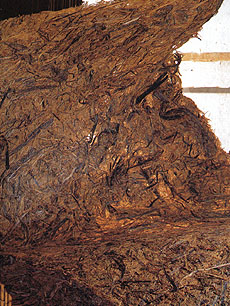 |
|
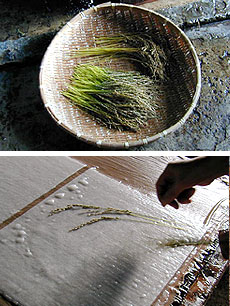 |
| Un-ryu-shi
(Japanese cedar washi) |
|
|
| |
|
|
|
"Washi
paper capturing the wilderness"
Kyomi's wilderness washi developed from her desire to incorporate
anything the good earth provides. There is something very pleasant
and dynamic about her washi. The small delicate, wild flowers floating
across the scooped paper pulp stock result into art pieces full
of energy. There is something dynamic and wholesome in her work.
The artist’s well-balanced lifestyle with the surrounding nature,
is reflected in her washi work, and the paper becomes one with nature.
Spring arrives very late to Noto, and the lovely little wild flowers
bloom all at once. The gathered flowers are scattered across the
wet sheets, adding colors of spring. The Japanese pampas grass ears,
rice grain harvests trapped inside the washi fibers leave impressions
of autumn. Anything, even the colorful leaves from the foliage season,
bean husks, rice plant stems, when they fall into her hands, harmoniously
mix with the washi raw materials Kozo (Broussonetia kazinoki Sieb.,
family Moraceae) and Gampi (Diplomorpha sikokiana Nakai, family
Thymelaeacea, genus Diplomorpha)). When grass and trees die with
the arrival of the cold winter, the seaweed are washed up along
the shores of Noto peninsula. It is their turn to play the title
role. These seaweed are excellent working material for Kyomi. Today,
the world focuses on ecological movements when producing products.
It just seems incredible from how long ago, the idea to work with
nature and utilize materials found locally, had been practiced with
such devotion.
|
| |
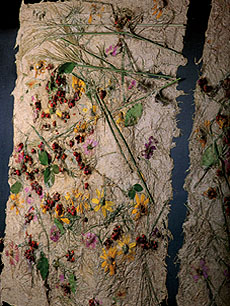 |
|
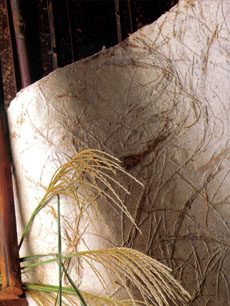 |
| Autumn
wilderness washi (Cosmoses, ivy plant flowers) |
|
Autumn
wilderness washi (Japanese pampas grass ears) |
| |
|
|
| |

|
|
|
 |
 |





